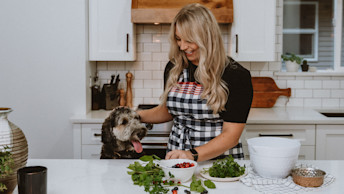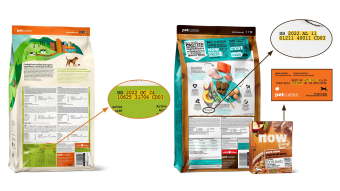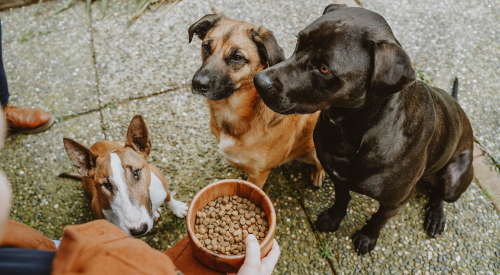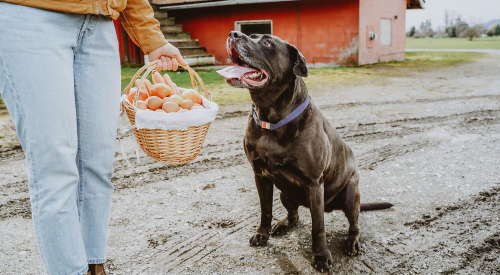November 17, 2022
Pet Food Safety & Quality Control FAQs

This blog was originally published on September 29, 2013. Last updated November 17, 2022.
How can I be sure that your recipes meet my pet’s nutritional requirements?
Petcurean recipes are developed by a team of qualified and passionate nutritionists. Our Nutrition Manager, Natalie Williams, has a MSc in Companion Animal Nutrition and a Bachelor of Science in Biological Science from the University of Guelph. Also on the team is one nutritionist with both a Bachelor of Science in Companion Animal Health and a Master of Science in Animal Science from the University of Alberta, plus an additional nutritionist with a Master of Science degree in animal nutrition from the University of Guelph. Thus, each nutritionist has at least six years of post-secondary education specializing in nutrition.
How do you guarantee quality in the manufacturing of your pet foods?
We approach the quality and safety of our pet foods with utmost care and we set extremely high quality and safety standards for ourselves and all of our suppliers and partners. Petcurean products are manufactured at plants which meet all regulatory requirements in addition to adhering to Petcurean’s high standards for partnership. We work with plants that are EU, FDA, and CFIA certified, meaning they must meet a very high standard of sanitation, cleanliness and manufacturing practices. Partners also participate in 3rd party audit programs, such as BRC or GFSI alongside our own partnership audits lead by a certified Food Safety and Quality auditor.
Our unique recipes are crafted using the highest quality ingredients which begins with a qualification program to approve all ingredient suppliers. Even when approved we test all ingredients prior to receiving them at the plant; quality assurance tests include, but are not limited to, vomitoxin, aflatoxin, zearalenone, nutritional integrity and moisture levels. Testing continues on every batch at each part of the manufacturing process built on standards set by Health Canada. We use Near Infra Red [NIR] technology during production to accurately measure the fat, protein and moisture content of the food. Prior to release, each batch is subject to further nutritional and quality testing, including for Enterobacteriaceae such as salmonella. Food is only shipped when favorable results are returned for all parameters. We keep final tested food samples of all lots produced in our nutrition office and regularly perform supplemental quality and nutrition testing for our own internal quality program.
Other components of our quality program include traceability of all products, each batch of food can be tracked immediately using our complete and thorough tracking protocol. We update and monitor our quality control procedures regularly.
As pet owners and animal lovers ourselves, we are committed to the health and safety of your pets and will continue to work diligently to ensure the quality and safety of all our products.
Are the containers used for your wet recipes BPA free?
All of our Go! Solutions and Now Fresh Tetra Pak recipes come in Tetra Pak cartons. They are a highly sustainable option in that they are manufactured from Forest Stewardship Council (FSC)-certified paperboard made from 65% renewable materials, they are recyclable, and they are more compact to ship, which means less impact on the environment. The lining of the Tetra Pak cartons is a food grade polypropylene layer, which is BPA free.
What is the shelf life of your dry and wet foods?
Our dry foods have a shelf life between 16 to 18 months depending on the recipe. The best before date can be found on every bag!
Our Go! Solutions and Now Fresh Tetra Pak products have a shelf life of 2 years.
Where do I find the “best before” dates on your products and how do I read them?
The best before dates on our Go! Solutions, Now Fresh products can be found on the back of the bag, on the bottom left-hand corner in the colored panel where the ‘feeding guidelines’ are located. On our Gather products, the code will appear on the top left-hand corner of the back of the bag. The code will look something like, “BB/MA 2025 AL 04”. Most people get confused by the BB/MA, but this just means ‘Best Before’ and then the French translation of ‘Meilleur Avant’. You can easily understand the date if you start with the year. This one is April 4, 2025.

On our Go! Solutions and Now Fresh Tetra Pak wet foods, the ‘Use By’ date is located on the top of the Tetra Pak.
What is the best way to store dry food?
Short answer: Dry food is best stored indoors in a cool dry place. If there is no zip closure, the top should be rolled down as far as possible and, if feasible, put in an airtight container, in the original bag. Dry food can also be frozen or refrigerated to maintain freshness.
(Slightly!) longer answer: Correct storage of pet food is extremely important to ensure the food is kept fresh (and enjoyable for your pet) and to ensure the well-being of your pet is protected.
Petcurean kibble is cooked and carefully dried to a specific moisture level before it’s placed in the bag (to prevent mold from forming).
To ensure that mold spores from environmental moisture don’t develop, be sure to store your kibble in a cool, dry location. Moist areas (like basements or crawl spaces), open containers, or areas where condensation or temperature fluctuations exist encourage mold to grow.
What about pouring your kibble into a storage container?
We receive an abundance of phone calls from our customers who profess they have the best dog food storage, e.g. the dreaded Rubbermaid tub.
Pouring pet food into these containers is absolutely not a good idea for two key reasons: many of these containers are not airtight (plastic is porous by nature), and fat and oils can be absorbed into the plastic, risking the opportunity for rancidity to occur.
So what is the best way to store my food? In the Petcurean bag you purchased for your pet at your local pet specialty retailer, stored in a cool, dry area of course!
Store open, sealed bags in an airtight container for an added level of protection.
Can I refrigerate or freeze my food?
Generally speaking, most kibble can be refrigerated or even frozen. The food should be tightly sealed or in airtight containers in either case.
How long can I keep an open container of food in the fridge?
Our Go! Solutions and Now Fresh Tetra Pak wet food should have the Tetra Pak top folded down and can also be kept in the fridge that way for 3 to 5 days. Wet food may also be frozen after opening but it’s best to transfer the product to an appropriate freezable container.
Do you do any testing on animals?
At Petcurean we believe that, if any of our new products aren’t fit to be tested on our own pets, then they shouldn’t be tested at all. To ensure our products perform up to our (and our customers) high standards we perform digestibility, palatability (taste), stool consistency, and urine pH testing in dogs and cats during our product development process.



